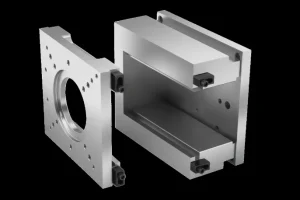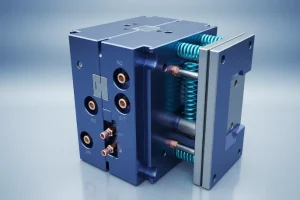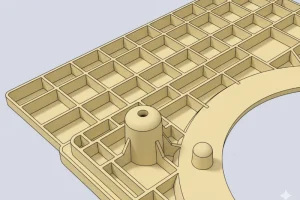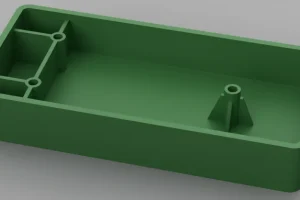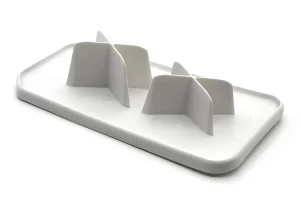TPE material is the common name of thermoplastic elastomer, the full English name is Thermoplastic Elastomer.
It is a kind of functional material that has both rubber elasticity and plastic stiffness and can be directly injected and extruded.
TPE overmolding is to overmold the TPE soft plastic material to other materials.
Generally, the processing methods used are two-color injection molding machines, or general injection molding machines, using the over-molding mold, in two injection molding.
The general application of the TPE material refers to the TPE-S polystyrene thermoplastic elastomer, which is a thermoplastic engineering plastic modified with SEBS or SBS elastomer as the base material.
TPE-S elastomer in the elastomer industry is also generally known as TPE or TPR.

TPE elastomer soft plastic material main advantages
TPE elastomer soft plastic material is used for secondary injection molding, injecton overmolding process.
Because TPE material has good non-slip properties and good elasticity, it can enhance the touch feeling of products and enhance the grip.
TPE elastomer can be adjusted to suitable hardness (hardness range Shore 25-90A) and suitable physical properties (such as wear resistance, scratch resistance, adhesion, melt index, etc.) according to the physical requirements of the product. This provides a variety of possible material applications for different products.
TPE is processed by injection overmolding and is commonly used in products such as handles, grips, and electronic materials.
The material gives the products a comfortable touch, improves the grip, enhances the aesthetics of the products and adds value to the products. Most of the products are exported to the United States, Japan and the European Union and other developed countries and regions.
Because TPE elastomer is safty material, the material does not contain phthalates, halogens, and 38 SVHC substances of great concern under REACH. It meets ROHS, REACH, NP, EN71, PAHS environmental testing standards, and can fully meet the environmental requirements of the United States, Japan, the European Union and other developed countries and regions.

TPE elastomer soft rubber processing technology
The TPE overmolding process generally adopts the secondary injection molding process, that is, the hard plastic parts are fixed on the overmolding mold, and then the TPE soft plastic material is injected and glued to the hard rubber parts under the suitable temperature, and the products are obtained by cooling.
The injection temperature of the overmolded plastic parts varies manufacturing according to the hard plastic material. The temperature should be considered so that both hard rubber and TPE soft plastuc materials should be softened in order to promote the compatibility of the two materials at the contact surface.
In order to achieve the effect of true overmolding production, usually the injection temperature of TPE overmolded PP material is about 170-190 degrees Celsius; overmolded ABS material is about 220-220 degrees Celsius; overmolded PC material is slightly higher than the injection temperature of overmolded ABS; overmolded PA nylon, the injection temperature should reach about 240 degrees Celsius.

TPE material common overmolded hard material
TPE is used in over-molding, TPE soft plastic material is used as a soft material cover layer, the common hard material for overmoulding is mainly plastic, also met,al and fabric.
TPE and woven fabric are mainly used in luggage products, and the same as metal overmolding, generally are false overmolding.
TPE can bond firmly with some common general plastic PP, GPPS, HIPS, ABS and engineering plastic PC, PC/ABS, PA and its modified materials.
The adhesion of TPE to POM is still a problem in the elastomer industry. Because the solubility parameter SP (22.6) of POM is very different from SP (7.2-7.6) of TPE, the two materials themselves are not compatible, and there is no suitable compatibilizer to promote good bonding between the two.

TPE overmolding attention issues
1. The compatibility of TPE and hard plastic parts should be matched, the molecular solubility is close to each other, the molecular compatibility is better;
2. Sharp corners should be avoided in the design to ensure excellent contact between TPE and hard plastic parts and to enhance the bonding effect;
3. Avoid leaving gas in the mold cavity by suitable exhaust;
4. Make the thickness of TPE and the expected touch to reach a balance;
5. Maintain the temperature of the TPE melt to ensure the bonding effect.
6. TPE overmoulding needs to be baked and reprocessed to reduce the surface water lines of the products and to obtain the effect of uniform surface color;
7. The carrier resin of the selected masterbatch is compatible with both TPE and structural part materials;
8. For the smooth surface to be specially treated, the purpose is to increase the contact surface of the soft and hard adhesive to strengthen the bonding effect;
9. TPE should have good flowability, because the thickness of TPE cover layer and size ratio is very small, TPE usually need to flow through a long path and thin-walled area to fill the mold.
10. The flow length/product thickness ratio of TPE is less than 150:1 ;
11. Use a good adhesive.

Defects of TPE overmoling and treatment solutions
Common defects
1. Lack of glue – increase the processing injection temperature; increase the injection pressure; improve the material flowability.
2. Split seam, overflow edge – lower the injection temperature; increase the clamping force; reduce the injection pressure; reduce the fluidity from the formulation point of view.
3. Surface pockmarked, not bright – increase the injection processing temperature; bake material, reduce the moisture of raw materials.
4. Poor adhesion – fully bake the material before injection processing; increase the injection temperature; adjust the formula.
5. Deformation of the product–strengthen the cooling of the mold; extend the clamping time appropriately.
6. Product sticky mold – add mold release agent or lubricant (for internal lubricant – mold release agent should pay attention to the amount added to prevent mold release agent precipitation and migration).

Solution
1. Adequate injection temperature. Overmolded nylon, TPE injection molding temperature should be above 190 degrees Celsius is good, not more than 240 degrees can be. In particular, to get the effect of true overmolding, because the softening temperature of nylon is 250-260 degrees, to ensure that the premise of TPE does not degrade, the closer the softening temperature of TPE and nylon, the better the effect of overmolding.
2. The design of the structure of the product cover glue part, try to achieve the size of the rounded, no obvious angles, to increase the TPE and nylon hard plastic material contact tightness.
3. In the nylon skeleton pieces of unimportant location to open some small holes, or create some not smooth surface, increase the contact area of TPE and nylon, so that the TPE soft plastic material through the small hole embedded in the nylon skeleton material, play a hoop embedded effect. In fact, the real package and fake package effect with.
4. For the new mold, need to pay attention to the design of the mold into the gate and runner.
Because the TPE cover layer is generally thin, the thickness of 1-2mm is common, and the size of the cover layer is generally in dozens or even hundreds of mm, so we must ensure that the TPE soft rubber can fill the mold cavity, no lack of glue, no split seam, to ensure the adhesion of TPE and nylon.

The main mechanism of TPE overmoulding
There is a distinction between true overmolding and false overmolding in TPE overmolding.
True overmolding is to use the compatibility of soft and hard adhesives when they are soft and molten (compatibility mainly depends on the solubility parameter SP, the closer the solubility parameter, the better the compatibility of the two materials.
For more information about SP, please refer to Polymer Chemistry), a bonding layer is formed on the contact surface of hard and soft rubber, which greatly enhances the adhesion of TPE soft plastic material to hard plastic.
False overmolding hardly involves the compatibility of the two materials, the material overmolding is through mechanical force, through the design of the mold and product and surface treatment, through the role of hoop inlay, so that the soft and hard plastic can be bonded together.

Summary
Through this article, we have learned about the TPE over-molding process, involving the selection of materials for overmolded products, considerations for injection mold production, and some problems that may be encountered in the injection molding process.
The TPE overmolding process involves a mold that requires more experience than conventional injection molding, so when the actual project is made. It is recommended to examine the experience of injection mold suppliers and injection molding production suppliers about overmolding mainly to avoid various problems in the actual production process and affect the progress of the project.


